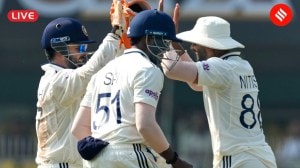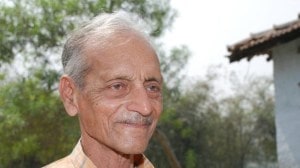Click here to join Express Pune WhatsApp channel and get a curated list of our stories
Mission Sun set for lift-off: Pune scientists wait for decade-long effort to bear fruit
SUIT is meant to image solar Photosphere and Chromosphere, two of the four outer layers of the Sun, in the ultraviolet range.
 (From L-R) Sreejith Padinhatteeri, Durgesh Tripathi and A N Ramaprakash.
(From L-R) Sreejith Padinhatteeri, Durgesh Tripathi and A N Ramaprakash. As Aditya-L1, India’s first spacecraft meant to study the Sun, gets ready for a launch this Saturday, a group of scientists at Pune’s Inter-University Centre for Astronomy and Astrophysics are nervously waiting for the culmination of their decade-long work. Durgesh Tripathi and A N Ramaprakash have worked for about ten years to develop the Solar Ultraviolet Imaging Telescope (SUIT), one of the main payloads on the Aditya-L1 mission.
“There is no relief till we know that the data we are getting through SUIT is good and meets the highest quality standards that we have set for ourselves. These are anxious moments for us, and the many talented and dedicated people we have been working with for the last so many years. One thing is for sure. The new science that SUIT is going to produce will be amazing,” Ramaprakash, 52, told The Indian Express.
SUIT is meant to image solar Photosphere and Chromosphere, two of the four outer layers of the Sun, in the ultraviolet range. Photosphere is the innermost of the outer layers, and the last one that is directly visible. Temperatures in this region varies between 3,700 and 6,200 degree Celsius. Chromosphere is the region just above the Photosphere. Here the temperatures are between 3,700 and 7,700 degree Celsius.
“What is going to follow the launch (on Saturday) is about four months of orbit transfers and travel to reach the Lagrangian Point L1, after which an insertion into the halo orbit will take place. Once there, the payloads, including SUIT, will be switched on,” said Sreejith Padinhatteeri, an assistant professor at the Manipal Centre for Natural Sciences, Manipal Academy of Higher Education in Manipal.
Sreejith, who continues as project scientist of SUIT, got associated with the IUCAA team in developing SUIT in 2017.
“Developing a UV telescope is always challenging because of the extreme requirements of contamination control. Even a particle of dust or molecules of oil or any other volatile organic components can significantly reduce the performance of the telescope and hence we had to always work in extremely clean labs, wearing all those fully covered, double-layer coats,” he said.
Durgesh Tripathi, 47, who has been working on SUIT since 2013, said this was the first kind of mission being undertaken by the Indian Space Research Organisation, so building the instruments took some time. “This is a highly technologically challenging mission and while there was a bit of slowdown during the Covid pandemic, work soon picked up. We have been working on developing the SUIT for the last 10-12 years and now it is giving me goosebumps…”
Ramprakash said Tripathi and he had started preparing for SUIT from the time they heard about ISRO’s plan to send a mission to Sun. “We could immediately sense the excitement. We knew we were going to be pushed out of our comfort zones. Space is very unforgiving. You have just one chance and you have to get it right. And to do that with something no one has ever done before, makes it that much more exciting,” he said.
He said that the first hurdle was to find experts.
“There were not many working in this field. We then decided to look for young talent, those who would not mind working long hours in difficult-to-work laboratory conditions. And that’s what we did. We assembled together a bunch of twenty somethings and set them going. The youngsters not only rose to the occasion but also found out of the box solutions to obstacles that would have otherwise made building the payload extremely difficult. In hindsight, it turned out to be one of the best decisions we had made. Now we have a good pool of people who can take even bigger challenges. This is the greatest satisfaction we have when we look forward to the launch,” Ramaprakash said.
Dibyendu Nandi, a professor at the Centre of Excellence in Space Sciences at IISER Kolkata, said SUIT would produce a rich set of data for the Aditya-L1 mission.
“The Aditya L1 mission is an ambitious solar observatory with the goal of addressing deep, unsolved mysteries of the Sun. It will seek answers to why stars have a super hot outer atmosphere known as the corona, how magnetic fields induce variations in the Sun’s radiation energy which has profound influence on our climate, and how violent solar storms are born. Aditya will also monitor the weather in space which adversely affects our space reliant technologies and the space industry. Needless to say I am also very excited about the SUIT instrument developed at IUCAA to which CESSI, IISER Kolkata made some contributions as a partner. SUIT will play a big role in science discoveries from the Aditya mission and it will return incredibly beautiful images of the Sun in all its glory, which I cannot wait to see,” he said.
Click here to join Express Pune WhatsApp channel and get a curated list of our stories








